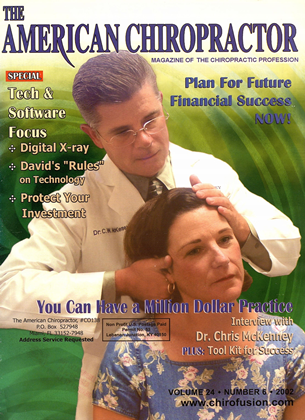Paying attention to what you say and comparing it to what you think is a powerful exercise iNTI-XiRITY CAN BE DEFINED as congruency between what you think, say, and do. This leads to personal effectiveness, Qc popular influence, and positive outcomes. However, if what you think is irrational or malevolent, followed by what you say and do, the outcomes will be destructive / rather than constructive. Some *i may define their level of effectiveness by the level of destruction they cause. A terrorist is a good example. A terrorist may have eongruency between what they think, say, and do, but that doesn't mean their brand of integrity is desirable. This article will focus on rational, constructive thinking in the context of chiropractic. My goal for the ideas I put forth here is to have them lead to increased success in your life and practice. Don't just read this; apply it, so that you may gain maximum benefit. Let's start with what you think. What is chiropractic to you? What is your goal for every patient/practice member that walks into your office? How will you know if you obtain this goal? How will your patient know if this goal is obtained? How do you explain it to your patient? What do you and your staff do in the office in relation to these thoughts and communications? Let's say, for example, your thoughts conclude that chiropractic is the detection and correction of vertebral subluxation (VS). Why? What is a subluxation? In other words, you should understand the thinking that has brought you to such conclusions, so that you are justified in your thoughts beyond the realm of dogma. Let's assume that you know enough about vertebral subluxation and chiropractic that your philosophical and scientific understanding forms your conclusions, rather than dogma. If your goal with each patient is detection and correction of VS (this is what you think), what do you say to them? In your thinking, is this a lifestyle concept that should last a lifetime? If so, is this what you are saying to your patients? Do you say to them that chiropractic is a lifestyle and not a treatment? Is everything you say congruent with your mindset? What questions do you ask them each time they come in? Mind you, this is a never-ending process of refinement. The more conscious you become of it, the greater your congruency, strength, effectiveness and integrity. Paying attention to what you say and comparing it to what you think is a powerful exercise. Not only should you apply it to your practice members, but also to your staff. Finally, what action steps do you take? Are they congruent with what you think and say? The most common corruption in chiropractic integrity is in the action phase. Many chiroprac- tors have a well reasoned out thought process when it comes to their understanding of chiropractic and VS. These same chiropractors have education systems in place in the office so that what they are saying is congruent with what they are thinking. The next question is, "What are you doing?" The "doing" starts with the consultation and exam. Many D.C.'s are still doing traditional ortho/neuro evaluations which are mostly ineffective in finding sublux- ation. In this case, you are thinking it and saying it, but not doing it. Integrity is lost and as a result so is effectiveness and success. Today, there is technology available which makes subluxation real and demonstrates the effectiveness and necessity of chiropractic care in ways your patients can understand it. Look into it! What else do you "DO"? How about your family? Do you do for them what you tell your patients is important? How about for yourself? Integrity would be doing for yourself and family exactly what you're telling your patients. Regular visits. Re-exams. Working on lowering lifestyle stress, and so on. Refining all these issues could take a book. The purpose of this article is to raise the issues and get you thinking about them and acting on them. Refinement starts on the macro level and proceeds to the micro level. A clue to a disconnect from thought to action is unfulfilled intention. For example, if you want to see lots of children in the practice, but it is not happening, somehow your desire in thought and vision is not manifesting. To correct that, look for the incongruity between what you think, say, and do. When you find the contradiction, remove it and watch things get better. Sounds easy, but when you apply it to the whole of your life, it can get quite complex. But heck, who needs easy. Success and happiness are worth the effort; so stop reading and get started! EZQ A 1983 graduate of Life College, Patrick Gentempo, Jr., D.C., is co-founder and CEO of the Chiropractic Leadership Alliance, in May wood, NJ, and co-creator of the Total Solution program. An internationally renowned chiropractor, lecturer, and consultant, he has helped thousands of chiropractors achieve success and balance in their lives. For information about CLA seminars, products, and services, call 800-285-2001, or visit www.suhluxalinn.cnm.
 View Full Issue
View Full Issue









